Thanks Again for Choocing Sunlight Solar Energy!
Blog
Reviews and information on the best Solar panels, inverters and batteries from SMA, Fronius, SunPower, SolaX, Q Cells, Trina, Jinko, Selectronic, Tesla Powerwall, ABB. Plus hybrid inverters, battery sizing, Lithium-ion and lead-acrid batteries, off-grid and on-grid power systems.
Most efficient solar panels 2022

Solar Console Efficiency
Solar panelefficiencyis a measure of the amount of sunlight (irradiation) that falls on the surface of a solar panel and is converted into electricity. Due to the many advances in photovoltaic engineering science over recent years, the boilerplate panel conversion efficiency has increased from fifteen% to well over twenty%. This large jump in efficiency resulted in the power rating of a standard size panel to increase from 250W upward to 370W.
As explained in item below, solar panel efficiency is determined past2 main factors;the photovoltaic (PV) cell efficiency, based on the jail cell pattern and silicon type, and the total panel efficiency, based on the cell layout, configuration and panel size.
Prison cell Efficiency
Cell efficiency is determined past the prison cell structure and type of substrate used, which is generally either P-type or N-type silicon. Prison cell efficiency is calculated by what is known equally the fill cistron (FF), which is the maximum conversion efficiency of a PV prison cell at the optimum operating voltage and current.
The jail cell design plays a significant role in panel efficiency. Central features include the silicon type, busbar configuration, and passivation type (PERC). Panels congenital using loftier-cost IBC cells are currently the most efficient (twenty-22%) due to the loftier purity N-blazon silicon substrate and no losses from busbar shading. However, panels developed using the latest monocrystalline PERC cells and more advanced heterojunction (HJT) cells take achieved efficiency levels well higher up twenty%.
Left: closeup of a P-type mono 5 busbar cell from a Trina Dearest 1000 plus 310W console . Right: closeup of a more than efficient Due north-type 12 multi busbar cell from a LG Neon two 335W panel. Click to enlarge image
Console Efficiency
Solar panel efficiency is measured under standard test conditions (STC), based on a prison cell temperature of 25°C, solar irradiance of 1000W/m2 and Air Mass of 1.5. The efficiency (%) of a console is effectively calculated by dividing the maximum power rating or Pmax (W) at STC, past the full panel area measured in meters squared.

Overall panel efficiency can be influenced by many factors including; temperature, irradiance level, cell type, and interconnection of the cells. Surprisingly, even the color of the protective backsheet can impact efficiency. A black backsheet might look more aesthetically pleasing, only it absorbs more oestrus resulting in higher jail cell temperature which increases resistance, this in plough slightly reduces total conversion efficiency.
The solar cell type, design and configuration all accept an impact on panel efficiency - Click to enlarge
Panels built using advanced 'Interdigitated dorsum contact' or IBC cells are the most efficient, followed past heterojunction (HJT) cells, half-cut and multi-busbar monocrystalline PERC cells, shingled cells and finally lx-cell (4-5 busbar) mono cells. 60 cell poly or multicrystalline panels are generally the least efficient and equally the lowest toll panels.
Top 10 almost efficient solar panels *
The concluding twelvemonth has seen a surge in manufacturers releasing more efficient solar panels based on loftier-performance Due north-type heterojunction or HJT cells. For the offset time, the efficiency of the top v panels is now to a higher place 22%. SunPower Maxeon panels even so lead the pack, but just but, equally the new Canadian Solar, Panasonic EverVolt H and REC Alpha Pure panels featuring Due north-blazon HJT cells are close backside. Loftier-performance panels from SPIC and Meyer Burger using IBC cells have too closed the gap, plus next-generation panels featuring multi-busbar (MBB) half-cutting N-type cells from Trina Solar and JA Solar have helped increase console efficiency well above 21%.
More efficient panels using N-blazon cells as well do good from a lower charge per unit of light-induced degradation or LID, which is as low as 0.25% of power loss per year. When calculated over the 25-year life of the console, many of these high-performance panels are guaranteed to still generate 90% or more of the original rated capacity, depending on the manufacturer's warranty details.
| # | Brand | Model | Power | Efficiency |
|---|---|---|---|---|
| i | SunPower | Maxeon three | 400 W | 22.six % |
| two | Canadian Solar | CS6R-MS | 440 W | 22.five % |
| three | LG | Neon R | 405 W | 22.3 % |
| 4 | Panasonic | EverVolt H | 410 W | 22.2 % |
| 5 | SPIC | Andromeda 2.0 | 435 W | 22.1 % |
| 6 | REC | Alpha Pure | 405W | 21.9 % |
| 7 | Trina Solar | Vertex Due south+ | 425 W | 21.9 % |
| 8 | Meyer Burger | White | 400 W | 21.7 % |
| 9 | JA Solar | Deep Blue three.0 | 420 Westward | 21.5 % |
| x | Silfab Solar | Aristocracy BK | 405 Due west | 21.4 % |
* Residential size panels - 60 to 66 cell (120-HC or 132-HC) and 96/104 cell formats. Does not include commercial panels greater than 2.0m in length.
Below is the latest Clean Free energy Reviews downloadable chart of the peak xx most efficient solar panels for 2022 with PV jail cell applied science details added for comparison.

* Listing of the most efficient solar panels appear and expected to accomplish high book product during 2022 - Residential 54 to 66 cell format size panels simply - Last update March 2022
Why efficiency matters
The term efficiency is thrown around a lot merely a slightly more efficient panel doesn't e'er equate to a ameliorate quality panel. Many people consider efficiency to be the nigh important criteria when selecting a solar panel, simply what matters almost is the manufacturing quality which is related to existent world performance, reliability, manufacturers service, and warranty conditions. Read more about selecting the best quality solar panels here.
Faster Payback
In ecology terms, increased efficiency by and large means a solar console will pay back the embodied free energy (free energy used to extract the raw materials and manufacture the solar panel) in less time. Based on detailed lifecycle analysis, about silicon-based solar panels already repay the embodied energy within two years, depending on the location. Nevertheless, as console efficiency has increased beyond 20%, payback time has reduced to less than 1.5 years in many locations. Increased efficiency besides means a solar organisation volition generate more electricity over the average xx+ year life of a solar console and repay the upfront cost sooner, significant the return on investment (ROI) will be improved farther.
Solar panel efficiency by and large gives a good indication of performance, especially as many high-efficiency panels utilize higher grade North-type silicon cells with improved temperature coefficient and lower ability degradation over time. Some manufacturers such equally LG, Panasonic and SunPower even offering warranties with xc% or higher retained power output after 25 years of utilise.
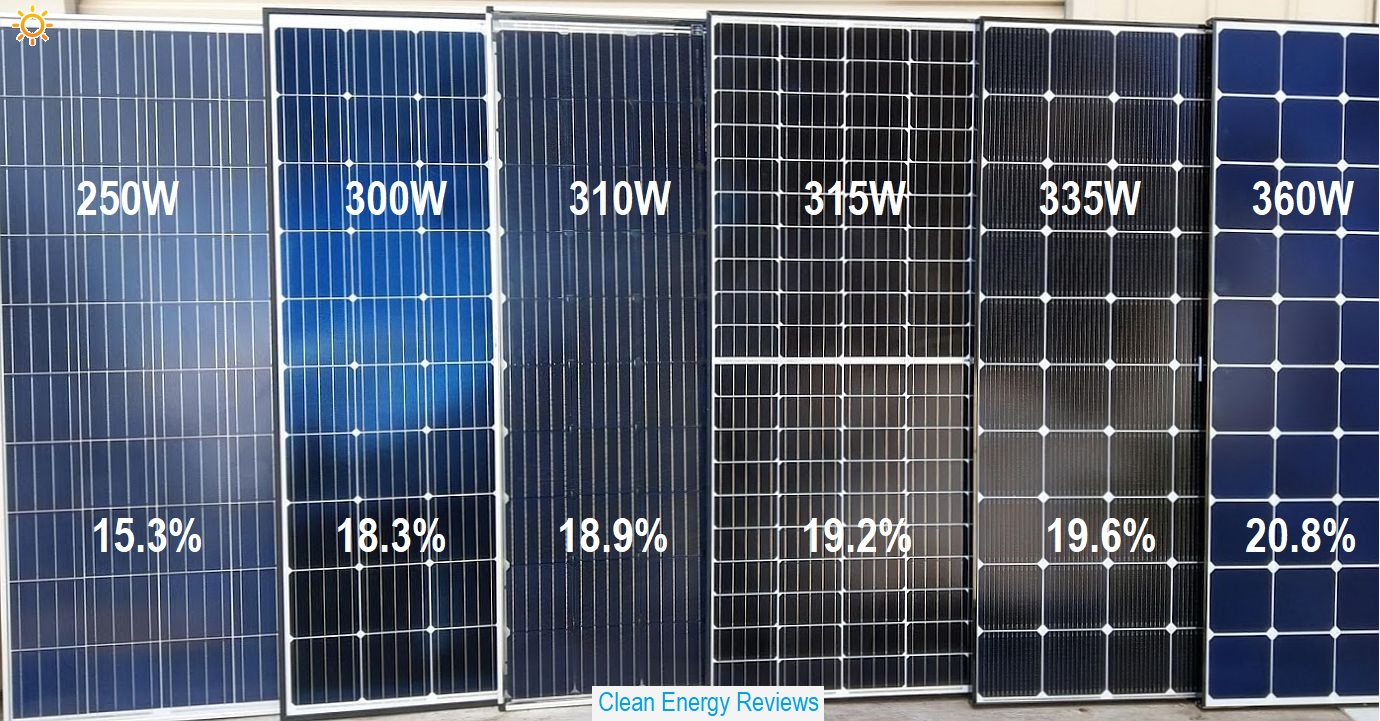
Solar panels with different efficiency - Trina 250W poly panel, 300W and 310W mono panels, 315W half-cut 120 prison cell, 335W multi-busbar and on the far right the high 20.8% efficiency 360W LG Neon R panel.
Area Vs Efficiency
Efficiency does make a big difference in the amount of roof area required. Higher efficiency panels generate more energy per foursquare meter and thus require less overall surface area. This is perfect for rooftops with express space and can also allow larger capacity systems to be fitted to any roof. For instance, 12 x loftier efficiency 400W solar panels, such every bit those from LG or SunPower with a 21.8% conversion efficiency, will provide around 1200W (1.2kW) more total solar capacity than the same number of similar size 300W panels with a lower 17.5% efficiency.
-
12 10 300W panels at 17.five% efficiency = iii,600 W
-
12 x 400W panels at 21.8% efficiency = four,800 W
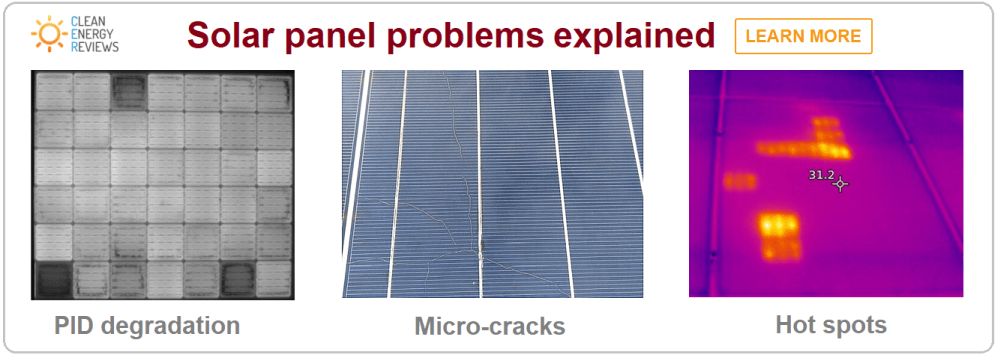
Real-world efficiency
In real-world use, solar console operating efficiency is dependent on many external factors. Depending on the local environmental weather condition these various factors can reduce console efficiency and overall organization performance. The main factors which affect solar panel efficiency are listed below:
-
Irradiance (W/m2)
-
Shading
-
Console orientation
-
Temperature
-
Location (latitude)
-
Time of year
-
Dust and dirt
The factors which have the most pregnant touch on on panel efficiency in existent-world utilize are irradiance, shading, orientation and temperature.
The power curves above highlight the relationship betwixt irradiance and panel power output.
The level of solar irradiance, measured in watts per square meter (W/m2), is influenced by atmospheric conditions such as clouds & smog, the breadth and time of year. Naturally, if a panel is fully shaded the power output volition be very low, just partial shading can as well accept a large bear upon, not simply on panel efficiency merely total system efficiency. For case, slight shading over several cells on a single console tin can reduce power output by fifty% or more than, which in turn can reduce the entire cord power past a like amount since most panels are connected in serial and shading one panel affects the whole string. Therefore information technology is very of import to effort to reduce or eliminate shading if possible. Luckily in that location are add-on devices known as optimisers and micro-inverters which tin can reduce the negative effect of shading, especially when only a minor number of panels are shaded.
Efficiency Vs temperature

The power rating of a solar panel, measured in Watts (W), is calculated nether Standard Test Conditions (STC) at a prison cell temperature of 25°C and an irradiance level of 1000W/m2. However, in existent-world use, prison cell temperature by and large rises well higher up 25°C, depending on the ambient air temperature, wind speed, time of day and amount of solar irradiance (W/m2). During sunny weather, the internal cell temperature is typically 20-30°C higher than the ambient air temperature, which equates to approximately 8-xv% reduction in total power output - depending on the type of solar cell and its temperature coefficient. To provide an average existent-world estimate of solar console performance, most manufacturers volition also specify the power rating under NOCT conditions or the Nominal Operating Cell Temperature. NOCT functioning is typically specified at a jail cell temperature of 45°C and a lower solar irradiance level of 800W/m2, which attempts to judge the average existent-world operating conditions of a solar panel.
Conversely, extremely cold temperatures tin can issue in an increase in ability generation above the nameplate rating every bit the PV cell voltage increases at lower temperatures beneath STC (25°C). Solar panels can exceed the console power rating (Pmax) for short periods of time during very cold weather. This frequently occurs when total sunlight breaks through after a catamenia of cloudy conditions.
The Ability Temperature Coefficient
Prison cell temperatures higher up or beneath STC will either reduce or increase the power output past a specific amount for every degree above or beneath 25°C. This is known as the power temperature coefficient which is measured in %/°C. Monocrystalline panels have an boilerplate temperature coefficient of -0.38% /°C, while polycrystalline panels are slightly college at -0.40% /°C. Monocrystalline IBC cells have a much amend (lower) temperature coefficient of effectually -0.30%/°C while the best performing cells at high temperatures are HJT (heterojunction) cells which are as low as -0.25% /°C.
Temperature coefficient comparison
The ability temperature coefficient is measured in % per °C - Lower is more efficient
-
Polycrystalline cells - 0.39 to 0.43 % /°C
-
Monocrystalline cells - 0.35 to 0.40 % /°C
-
Monocrystalline IBC cells - 0.28 to 0.31 % /°C
-
Monocrystalline HJT cells - 0.25 to 0.27 % /°C
The chart beneath highlights the difference in power loss betwixt panels using different PV cell types. Due north-blazon heterojunction (HJT) and IBC cells bear witness far lower power loss at elevated temperatures compared with mutual poly and monocrystalline PERC cells.

Solar panel Power Vs Temperature comparison chart for various cell types - Note, the jail cell (panel) temperature is typically 20 to thirty deg C higher up the ambient air temperature.
Power Vs Temperature nautical chart notes:
-
STC = Standard test atmospheric condition (25°C)
-
NOCT = Nominal operating cell temperature (45°C)
-
(^) High cell temp = Typical cell temperature during hot summer conditions (65°C)
-
(#) Maximum operating temp = Maximum panel operating temperature during extremely loftier temperatures mounted on a dark rooftop (85°C)
Cell temperature is generally 20°C higher than the ambient air temperature which equates to a 5-eight% reduction in power output at NOCT. However, jail cell temperature tin can rise as high every bit 85°C when mounted on a night coloured rooftop during very hot 45°C, windless days which is generally considered the maximum operating temperature of a solar panel.
most efficient solar Cells
The near efficient solar panels on the market mostly use either North-type (IBC) monocrystalline silicon cells or the some other highly efficient N-type variation, heterojunction (HJT) cells. Most other manufacturers currently utilise the more common P-blazon mono-PERC cells; however, several large volume manufacturers, including JinkoSolar, Longi Solar and Trina, are now starting to shift to the more efficient N-type cells.
Efficiency of different solar PV cell types
-
Polycrystalline - 15 to 18%
-
Monocrystalline - 16.five to nineteen%
-
Polycrystalline PERC - 17 to xix.5%
-
Monocrystalline PERC - 17.5 to 20%
-
Monocrystalline Due north-type - nineteen to xx.v%
-
Monocrystalline N-type HJT - 19 to 21.seven%
-
Monocrystalline North-type IBC - xx to 22.vi%

* Approximate average solar PV cell efficiency comparison chart - Mono and poly silicon types
Cost Vs Efficiency
All manufacturers produce a range of panels with different efficiency ratings depending on the silicon type used and whether they comprise PERC, multi busbar or other cell technologies. Very efficient panels above 21% featuring N-type cells are generally much more expensive, and then if cost is a major limitation it would be better suited to locations with limited mounting space, otherwise, y'all can pay a premium for the same power capacity which could be achieved by using i or ii additional panels. However, high-efficiency panels using N-type cells volition near always outperform and outlast panels using P-type cells due to the lower rate of lite-induced deposition or Lid, so the extra cost is ordinarily worth it in the long term.
For Instance, a high-efficiency 400W+ panel could cost $350 or more while a common 330W console volition typically price closer to $170. This equates to roughly $0.50 per watt compared to $0.90 per watt. Although in the case the leading manufacturers such as LG, Sunpower and REC the more than expensive panels have higher operation, lower degradation rates and more often than not come with a longer manufacturer or production warranty menstruation, so it is often a wise investment.
Acquire more about solar panel warranties here .
Console Size Vs Efficiency
Panel efficiency is calculated by the power rating divided by the total panel area, so simply having a larger size panel does non always equate to higher efficiency. Even so, larger panels using larger size cells increases the prison cell area which does boost overall efficiency.
Most common residential panels even so use the standard 6" (156mm) square sixty-prison cell panels while commercial systems use the larger format 72 cell panels. Withal, as explained below, a new industry trend emerged in 2020 towards much larger panel sizes built around new larger size cells which increased panel efficiency and additional power output upwards to an impressive 600W.
Common Solar panel sizes
-
threescore cell panel (120 HC) : Approx width 0.98m 10 length i.65m
-
72 jail cell panel (144 HC) : Approx width 1.0m ten length ii.0m
-
96/104 cell panel: Approx width one.05m 10 length ane.60m
-
66 jail cell panel (132 HC) - Approx width 1.10m x length i.80m - New*
-
78 cell console (156 HC): Approx width i.30m 10 length ii.3m - New*
HC = one-half-cut cells
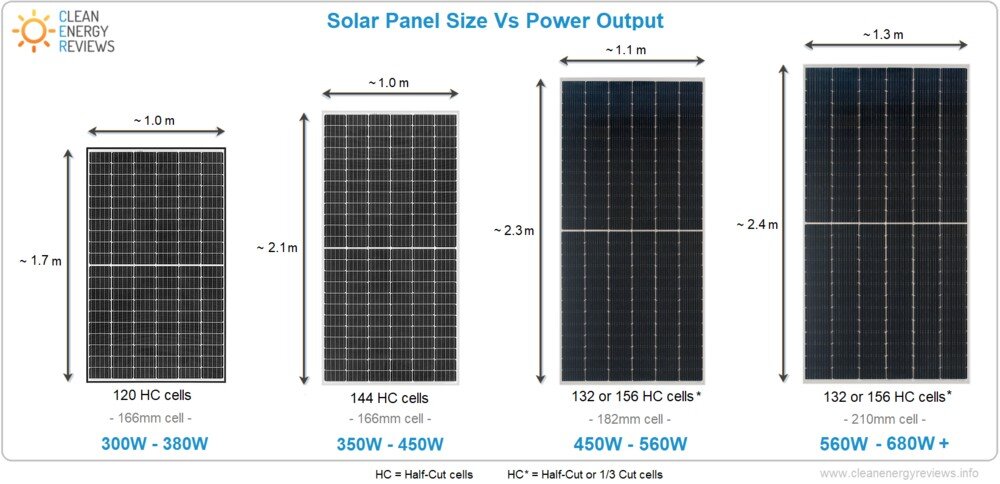
A standard size 60-cell (1m x i.65m) panel with eighteen-xx% efficiency typically has a power rating of 300-330 Watts, whereas a panel using higher efficiency cells, of the same size, can produce up to 370W. As previously explained, the nigh efficient standard-size panels employ loftier-performance N-blazon IBC or Interdigitated Dorsum Contact cells which can reach up to 22.6% panel efficiency and generate an impressive 380 to 400 Watts.
Popular one-half-cut or split cell modules accept double the number of cells with roughly the same console size. A console with 60 cells in a half-prison cell format is doubled to 120 cells, and 72 cells in a half-cell format have 144 cells. The one-half-cut cell configuration is slightly more efficient every bit the panel voltage is the aforementioned but the current is split between the two halves. Due to the lower current, half-cut panels have lower resistive losses resulting in increased efficiency and a lower temperature co-efficient which also helps boost operating efficiency.
New Larger cells and high power 600W+ panels
To subtract manufacturing costs, gain efficiency and powerful solar panels, manufacturers have started moving away from the standard 156mm (6") square cell wafer size in favour of larger wafer sizes. While at that place are a variety of various prison cell sizes nether evolution with the about popular being 166mm, 182mm and 210mm. The larger cells combined with new larger panel formats accept enabled manufacturers to develop extremely powerful solar panels with ratings up to 670W. Larger cell sizes have a greater area and when combined with the latest cell technologies such as multi-busbar (MBB), PERC and tiling ribbon, tin boost panel efficiency up to 22%.
Source: https://www.cleanenergyreviews.info/blog/most-efficient-solar-panels


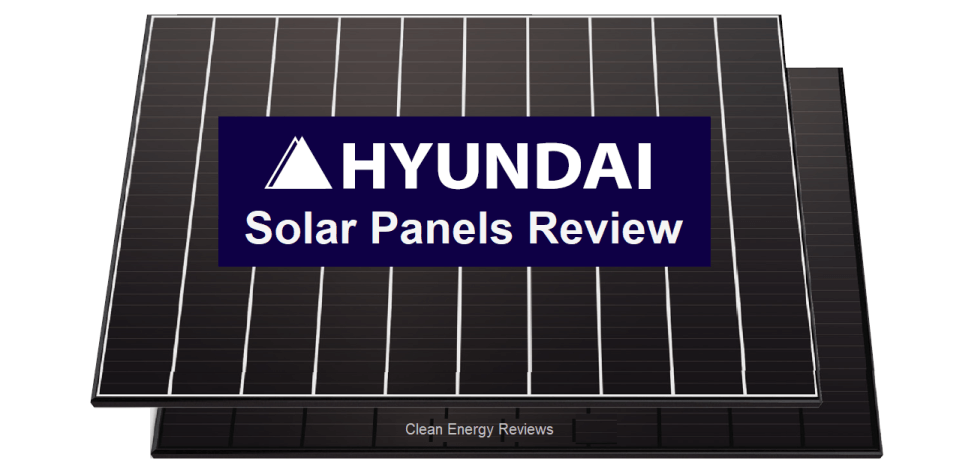

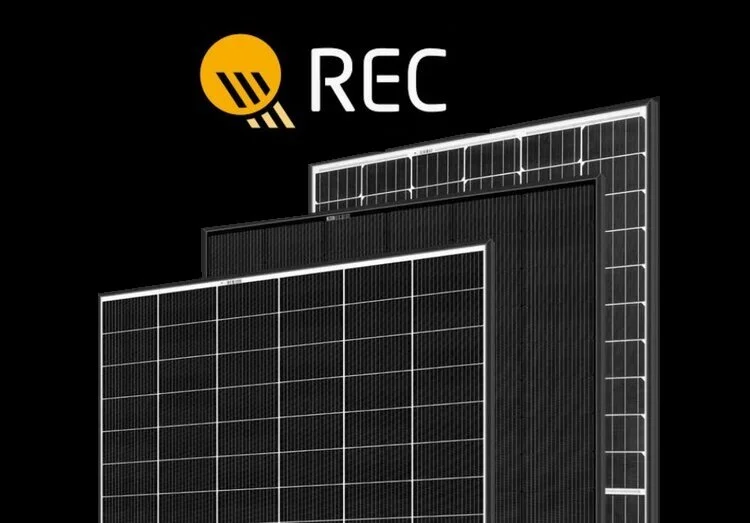

0 Response to "Thanks Again for Choocing Sunlight Solar Energy!"
Postar um comentário